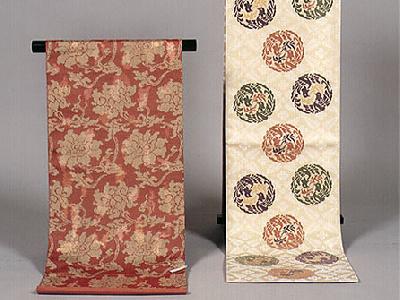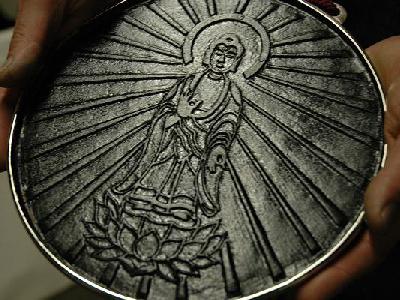|
Hyoji Kitagawa (born 1936) is the second son of Heirô Kitagawa, the 17th generation head of the Tawaraya (and holder of this important intangible cultural property). In 1988, he succeeded his father and became the 18th generation head of the Tawaraya.
Kitagawa works for the imperial household as a brocade artisan and is acclaimed for his sophisticated weaving skills. He testified his brilliant techniques to the world when reproducing the ancient Kajyu-Shishi-Jinbutsu-Monaya brocade for the Shosoin repository in Nara. Usig a magnifying glass, he studied the original brocade pattern in great detail to make a thread-by-thread transcript on a cross-section. He accomplished this extremely precise work in only three years.
In 1989, he made complex gauze brocades, such as 'nishiki', 'ra' and 'sha', to be used with votive objects at the Ise Shrine. In 1990, he made the ceremonial costumes 'gosokutai' and 'jyu-ni-tan' for the marriage of prince and princess Akishino, and also for the Emperor's coronation. In 1993, he made wedding costumes for the marriage of crown prince Naruhito to princess Masako.
In 1999, he was honored as a Living National Treasure.
Kitagawa works for the imperial household as a brocade artisan and is acclaimed for his sophisticated weaving skills. He testified his brilliant techniques to the world when reproducing the ancient Kajyu-Shishi-Jinbutsu-Monaya brocade for the Shosoin repository in Nara. Usig a magnifying glass, he studied the original brocade pattern in great detail to make a thread-by-thread transcript on a cross-section. He accomplished this extremely precise work in only three years.
In 1989, he made complex gauze brocades, such as 'nishiki', 'ra' and 'sha', to be used with votive objects at the Ise Shrine. In 1990, he made the ceremonial costumes 'gosokutai' and 'jyu-ni-tan' for the marriage of prince and princess Akishino, and also for the Emperor's coronation. In 1993, he made wedding costumes for the marriage of crown prince Naruhito to princess Masako.
In 1999, he was honored as a Living National Treasure.
| [+ADDRESS] | 
|
















